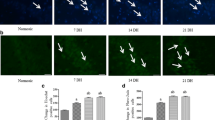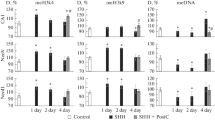Abstract
Epigenetic mechanisms are involved in the maintenance of long-term hypoxia-adapted cellular functions. Astrocytes as the dividing neuroglia cell in the nervous tissue can be activated under hypoxia condition. In the present study, the epigenetic characteristics such as DNA methylation and histone acetylation, as well as S-adenosylmethionine (SAM) role were explored in cultured astrocytes under ischemia-hypoxia (IH) condition. IH could induce the hypermethylation of global DNA and hypoacetylation of histone H3/H4 in an enzyme-dependent manner. c-Jun amino terminal kinase (JNK) signal pathway was involved in this epigenetic change induced by IH. SAM revealed a reverse effect on protein expression without the involvement of methyl donor. On the other hand, neither change of global DNA nor specific gene methylation level was observed in non-dividing neurons under IH condition. In conclusion, a genome-wide adjustment of DNA methylation and histone acetylation under IH conditions should be involved in epigenetic programming of astrocytes. Understanding how ischemia-hypoxia affects global and gene-specific epigenetic programming will provide important insights into the mechanisms of hypoxia-induced cellular changes.





Similar content being viewed by others
References
White L, Petrovitch H, Hardman J, Nelson J, Davis DG, Ross GW, Masaki K, Launer L, Markesbery WR (2002) Cerebrovascular pathology and dementia in autopsied Honolulu-Asia aging study participants. Ann N Y Acad Sci 977:9–23
Aalami OO, Fang TD, Song HM, Nacamuli RP (2003) Physiological features of aging persons. Arch Surg 138(10):1068–1076. doi:10.1001/archsurg.138.10.1068
Bakker FC, Klijn CJ, Jennekens-Schinkel A, Kappelle LJ (2000) Cognitive disorders in patients with occlusive disease of the carotid artery: a systematic review of the literature. J Neurol 247(92):669–676
Sekhon LH, Morgan MK, Spence I, Weber NC (1997) Chronic cerebral hypoperfusion: pathological and behavioral consequences. Neurosurgery 40(3):548–556
Tsai YP, Wu KJ (2014) Epigenetic regulation of hypoxia-responsive gene expression: focusing on chromatin and DNA modifications. Int J Cancer 134(2):249–256. doi:10.1002/ijc.28190
Watson JA, Watson CJ, McCann A, Baugh J (2010) Epigenetics, the epicenter of the hypoxic response. Epigenetics 5(4):293–296
Chouliaras L, Rutten BP, Kenis G, Peerbooms O, Visser PJ, Verhey F, van Os J, Steinbusch HW, van den Hove DL (2010) Epigenetic regulation in the pathophysiology of Alzheimer's disease. Prog Neurobiol 90(4):498–510. doi:10.1016/j.pneurobio.2010.01.002
Marques SC, Lemos R, Ferreiro E, Martins M, de Mendonca A, Santana I, Outeiro TF, Pereira CM (2012) Epigenetic regulation of BACE1 in Alzheimer's disease patients and in transgenic mice. Neuroscience 220:256–266. doi:10.1016/j.neuroscience.2012.06.029
Johnson AB, Denko N, Barton MC (2008) Hypoxia induces a novel signature of chromatin modifications and global repression of transcription. Mutat Res 640(1–2):174–179. doi:10.1016/j.mrfmmm.2008.01.001
Feinberg AP (2007) Phenotypic plasticity and the epigenetics of human disease. Nature 447(7143):433–440. doi:10.1038/nature05919
Esteller M (2008) Epigenetics in cancer. N Engl J Med 358(11):1148–1159. doi:10.1056/NEJMra072067
Gerhauser C (2013) Cancer chemoprevention and nutriepigenetics: state of the art and future challenges. Top Curr Chem 329:73–132. doi:10.1007/128_2012_360
Marques SC, Oliveira CR, Pereira CM, Outeiro TF (2011) Epigenetics in neurodegeneration: a new layer of complexity. Prog Neuropsychopharmacol Biol Psychiatry 35(2):348–355. doi:10.1016/j.pnpbp.2010.08.008
Urdinguio RG, Sanchez-Mut JV, Esteller M (2009) Epigenetic mechanisms in neurological diseases: genes, syndromes, and therapies. Lancet Neurol 8(11):1056–1072. doi:10.1016/S1474-4422(09)70262-5
Bertram L, Tanzi RE (2005) The genetic epidemiology of neurodegenerative disease. J Clin Invest 115(6):1449–1457. doi:10.1172/JCI24761
Pekny M, Nilsson M (2005) Astrocyte activation and reactive gliosis. Glia 50(4):427–434. doi:10.1002/glia.20207
Pekny M, Wilhelmsson U, Pekna M (2014) The dual role of astrocyte activation and reactive gliosis. Neurosci Lett 565:30–38. doi:10.1016/j.neulet.2013.12.071
Verkhratsky A, Olabarria M, Noristani HN, Yeh CY, Rodriguez JJ (2010) Astrocytes in Alzheimer's disease. Neurotherapeutics 7(4):399–412. doi:10.1016/j.nurt.2010.05.017
Wu X, Sun J, Zhang X, Li X, Liu Z, Yang Q, Li L (2014) Epigenetic signature of chronic cerebral hypoperfusion and beneficial effects of S-adenosylmethionine in rats. Mol Neurobiol. doi:10.1007/s12035-014-8698-5
Gu X, Sun J, Li S, Wu X, Li L (2013) Oxidative stress induces DNA demethylation and histone acetylation in SH-SY5Y cells: potential epigenetic mechanisms in gene transcription in Aβ production. Neurobiol Aging 34(4):1069–1079. doi:10.1016/j.neurobiolaging.2012.10.013
Bhattacharya SK, Ramchandani S, Cervoni N, Szyf M (1999) A mammalian protein with specific demethylase activity for mCpG DNA. Nature 397(6720):579–583. doi:10.1038/17533
Tanaka T, Kato H, Kojima I, Ohse T, Son D, Tawakami T, Yatagawa T, Inagi R, Fujita T, Nangaku M (2006) Hypoxia and expression of hypoxia-inducible factor in the aging kidney. J Gerontol A Biol Sci Med Sci 61(8):795–805
Xia X, Lemieux ME, Li W, Carroll JS, Brown M, Liu XS, Kung AL (2009) Integrative analysis of HIF binding and transactivation reveals its role in maintaining histone methylation homeostasis. Proc Natl Acad Sci U S A 106(11):4260–4265. doi:10.1073/pnas.0810067106
Watson JA, Watson CJ, McCrohan AM, Woodfine K, Tosetto M, McDaid J, Gallagher E, Betts D, Baugh J, O'Sullivan J, Murrell A, Watson RW, McCann A (2009) Generation of an epigenetic signature by chronic hypoxia in prostate cells. Hum Mol Genet 18(19):3594–3604. doi:10.1093/hmg/ddp307
Shahrzad S, Bertrand K, Minhas K, Coomber BL (2007) Induction of DNA hypomethylation by tumor hypoxia. Epigenetics 2(2):119–125
Varela-Rey M, Iruarrizaga-Lejarreta M, Lozano JJ, Aransay AM, Fernandez AF, Lavin JL, Mosen-Ansorena D, Berdasco M, Turmaine M, Luka Z, Wagner C, Lu SC, Esteller M, Mirsky R, Jessen KR, Fraga MF, Martinez-Chantar ML, Mato JM, Woodhoo A (2014) S-adenosylmethionine levels regulate the Schwann cell DNA methylome. Neuron 81(5):1024–1039. doi:10.1016/j.neuron.2014.01.037
Tohgi H, Utsugisawa K, Nagane Y, Yoshimura M, Genda Y, Ukitsu M (1999) Reduction with age in methylcytosine in the promoter region -224 approximately -101 of the amyloid precursor protein gene in autopsy human cortex. Brain Res Mol Brain Res 70(2):288–292
Mastroeni D, Grover A, Delvaux E, Whiteside C, Coleman PD, Rogers J (2011) Epigenetic mechanisms in Alzheimer's disease. Neurobiol Aging 32(7):1161–1180. doi:10.1016/j.neurobiolaging.2010.08.017
Zhang X, Le W (2010) Pathological role of hypoxia in Alzheimer's disease. Exp Neurol 223(2):299–303. doi:10.1016/j.expneurol.2009.07.033
Peers C, Dallas ML, Boycott HE, Scragg JL, Pearson HA, Boyle JP (2009) Hypoxia and neurodegeneration. Ann N Y Acad Sci 1177:169–177. doi:10.1111/j.1749-6632.2009.05026.x
Pande M, Hur J, Hong Y, Backus C, Hayes JM, Oh SS, Kretzler M, Feldman EL (2011) Transcriptional profiling of diabetic neuropathy in the BKS db/db mouse: a model of type 2 diabetes. Diabetes 60(7):1981–1989. doi:10.2337/db10-1541
Shea TB, Chan A (2008) S-adenosyl methionine: a natural therapeutic agent effective against multiple hallmarks and risk factors associated with Alzheimer's disease. J Alzheimers Dis 13(1):67–70
Lee S, Lemere CA, Frost JL, Shea TB (2012) Dietary supplementation with S-adenosyl methionine delayed amyloid-β and tau pathology in 3xTg-AD mice. J Alzheimers Dis 28(2):423–431. doi:10.3233/JAD-2011-111025
Chiang PK, Gordon RK, Tal J, Zeng GC, Doctor BP, Pardhasaradhi K, McCann PP (1996) S-Adenosylmethionine and methylation. FASEB J 10(4):471–480
Medina M, Urdiales JL, Amores-Sanchez MI (2001) Roles of homocysteine in cell metabolism: old and new functions. Eur J Biochem 268(14):3871–3882
Shearstone JR, Pop R, Bock C, Boyle P, Meissner A, Socolovsky M (2011) Global DNA demethylation during mouse erythropoiesis in vivo. Science 334(6057):799–802. doi:10.1126/science.1207306
Lee ST, Xiao Y, Muench MO, Xiao J, Fomin ME, Wiencke JK, Zheng S, Dou X, de Smith A, Chokkalingam A, Buffler P, Ma X, Wiemels JL (2012) A global DNA methylation and gene expression analysis of early human B-cell development reveals a demethylation signature and transcription factor network. Nucleic Acids Res 40(22):11339–11351. doi:10.1093/nar/gks957
Fabbri M, Garzon R, Cimmino A, Liu Z, Zanesi N, Callegari E, Liu S, Alder H, Costinean S, Fernandez-Cymering C, Volinia S, Guler G, Morrison CD, Chan KK, Marcucci G, Calin GA, Huebner K, Croce CM (2007) MicroRNA-29 family reverts aberrant methylation in lung cancer by targeting DNA methyltransferases 3A and 3B. Proc Natl Acad Sci U S A 104(40):15805–15810. doi:10.1073/pnas.0707628104
Bottiglieri T (2002) S-Adenosyl-l-methionine (SAMe): from the bench to the bedside–molecular basis of a pleiotrophic molecule. Am J Clin Nutr 76(5):1151S–1157S
Lieber CS, Packer L (2002) S-Adenosylmethionine: molecular, biological, and clinical aspects—an introduction. Am J Clin Nutr 76(5):1148S–1150S
Lu SC (2000) S-Adenosylmethionine. Int J Biochem Cell Biol 32(4):391–395
Chervona Y, Costa M (2012) The control of histone methylation and gene expression by oxidative stress, hypoxia, and metals. Free Radic Biol Med 53(5):1041–1047. doi:10.1016/j.freeradbiomed.2012.07.020
MacDonald JL, Roskams AJ (2009) Epigenetic regulation of nervous system development by DNA methylation and histone deacetylation. Prog Neurobiol 88(3):170–183
Quiroz-Baez R, Rojas E, Arias C (2009) Oxidative stress promotes JNK-dependent amyloidogenic processing of normally expressed human APP by differential modification of alpha-, beta- and gamma-secretase expression. Neurochem Int 55(7):662–670. doi:10.1016/j.neuint.2009.06.012
Guglielmotto M, Giliberto L, Tamagno E, Tabaton M (2010) Oxidative stress mediates the pathogenic effect of different Alzheimer's disease risk factors. Front Aging Neurosci 2:3. doi:10.3389/neuro.24.003.2010
Hermann A, Gowher H, Jeltsch A (2004) Biochemistry and biology of mammalian DNA methyltransferases. Cell Mol Life Sci 61(19–20):2571–2587. doi:10.1007/s00018-004-4201-1
Acknowledgments
This work was supported by National Natural Science Foundation (No. 81070926 and No. 81271310).
Conflict of Interest
The authors declare no conflict of interests.
Author information
Authors and Affiliations
Corresponding author
Electronic Supplementary Material
Below is the link to the electronic supplementary material.
Supplementary Fig. 1
Schematic diagram of APP and BACE1 genes. The transcripts were composed of a 5’-untranslated region (UTR) with internal promoter activity, open reading frame (ORF), and a 3’-UTR. (A) The sequence represents a 240-bp fragment (between 26 and 266) in APP gene. (B) The sequence represents a 250-bp fragment (between -318 and -58) in BACE1 gene. The number refers to the location of cytosine-guanine (CpG) sites and underlying highlights of CpG sites include more than 1 CpG site tested at the same time. (GIF 136 kb)
Supplementary Fig. 2
Micrographs of cultured astrocytes and neurons. (A) Representative cultured astrocytes were immunocytochemically stained against GFAP (green). (B) Representative cultured neurons were immunocytochemically stained against Tuj1 (green). Scale bar = 50 μm. (GIF 71 kb)
Supplementary Fig. 3
Evaluation of cell viability for cultured cells under IH treatment. The cultured cells subjected to IH treatment were double stained by Hoechst 33258 (blue) and PI (red). (A) Control, (B) IH treatment for 24 h, (C) IH treatment for 48 h, (D) IH treatment for 72 h. Scale bar = 100 μm. (E) The number of dead cells after IH treatment. The data were expressed as mean ± SD. *p = < 0.05; **p < 0.01 vs. control group (n = 3). (GIF 147 kb)
Rights and permissions
About this article
Cite this article
Yang, Q., Wu, X., Sun, J. et al. Epigenetic Features Induced by Ischemia-Hypoxia in Cultured Rat Astrocytes. Mol Neurobiol 53, 436–445 (2016). https://doi.org/10.1007/s12035-014-9027-8
Received:
Accepted:
Published:
Issue Date:
DOI: https://doi.org/10.1007/s12035-014-9027-8




